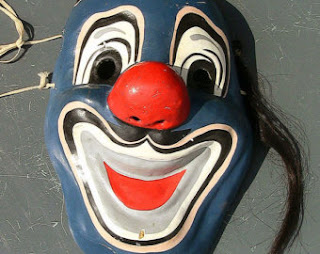The recent scary clown mask craze has a retro-whiff about
it. Rather than people being hounded by
trolls on the information super-highway, they are being menaced by clowns on
the streets of their neighbourhood.
Although an ancient art, clowning has a great deal in common
with trolling in particular the use of the mask. All clowns put on a mask, of course, as a
method of distancing themselves from their day to day personality, and also as
a licence to behave on the edges of acceptability.
Trolling too is a form of mask-making. While it is hard to define precisely what
trolling is, my millennial students reliably inform me it is not so much
bullying on line as taking on an exaggerated persona to get the most effect:
being excessively insulted by something, being overly violent in your online
responses, taking up exaggerated positions on topics and so on. When you toll someone you use the anonymity
of digital masking to create a mask for yourself that is more impactful,
violent and share-friendly.
Indeed both trolls and clowns share in the use of the mask
to distance themselves, from their real selves, and to also distance themselves
from their effect on others. But more
than this trolling and clowning share a symbiotic i-relationship. The recent proposed Clowns Lives Matter March
was organised through, what else, social media.
Facebook and Twitter have been sources for organising attacks and sharing
imagery inciting further attacks.
So it would appear that clowning adds a new physicality to
online bullying. While trolling can have
tangible real-world effects in extreme cases, mostly the cost is virtual. With clowning the disaffected of the world
are closing their laptops, coming out of their bedrooms and taking back the
streets.
It was only a matter of time before the currency of the web,
likes and shares, until recently the crack cocaine of contemporary social life,
would lose its edge. In the run up to
Halloween there is a new drug in town, dopamine, the fight or flight drug that
you can only score on the street when you are mask to face with your
victim.
Does this mark a decline in virtual violence, as I said a
retro-shift back to a kind of Clockwork Orange world of ultra-violence? Or does it draw a new frontier where the
social drug of sharing is cut with the brain-drug of scaring to produce a new
high for bullies around the globe? Whatever the answer it is clear, as Victor
Hugo once said, “Virtue has a veil, vice a mask”.

Comments